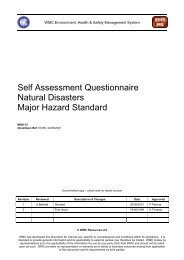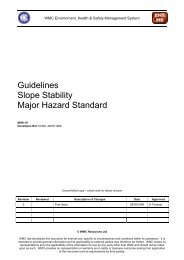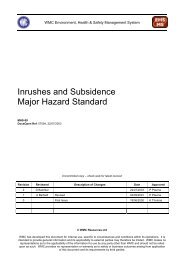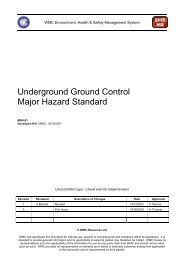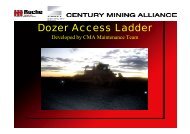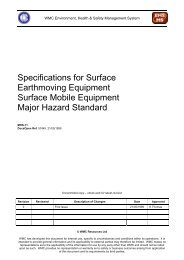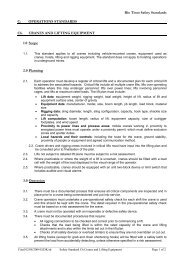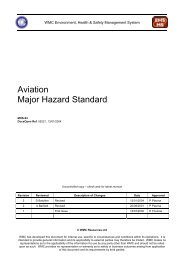Safety Wise Solutions_ICAM.pdf - MIRMgate
Safety Wise Solutions_ICAM.pdf - MIRMgate
Safety Wise Solutions_ICAM.pdf - MIRMgate
Create successful ePaper yourself
Turn your PDF publications into a flip-book with our unique Google optimized e-Paper software.
Systemic Incident Investigation<br />
Annual Quarrying & Small Mines<br />
<strong>Safety</strong> & Health Seminar
A Few Questions<br />
• What worries you<br />
• Where will your next incident happen<br />
• What occupies most of your time<br />
• Had any new incidents lately<br />
• What’s wrong with what we have been doing for years<br />
Why change now
Today’s Operating Environment<br />
Maximum return to shareholder<br />
Keep operating licence<br />
What price<br />
safety<br />
Management<br />
strategies & decisions<br />
Keep DME<br />
sweet<br />
How safe is<br />
safe enough<br />
Accident<br />
Incident<br />
Near miss<br />
Equip.failure<br />
Production loss<br />
Prove due<br />
diligence<br />
Public expects &<br />
demands zero risk<br />
Stakeholder &<br />
society demands<br />
Good corporate<br />
citizen<br />
Repeat incidents are a symptom of poor investigations<br />
and management of corrective actions<br />
Zero Harm ethical organisation
What is Needed:<br />
• A risk-based foundation for management systems<br />
• More sophisticated risk and incident management processes<br />
• Integration of risk management process into the company’s decision<br />
making processes<br />
• Using every incident as an opportunity to reduce risk in our business<br />
processes and prevent repeat events
Tools for a safe system<br />
Management support understanding & commitment<br />
Behavioural<br />
safety<br />
Safe conditions<br />
& equipment<br />
Safe behaviours<br />
Safe operating<br />
procedures<br />
Compliance<br />
Risk<br />
management<br />
Safe System Design
What is the process<br />
What is an investigation What do we want from it<br />
Step Determine Process Tools<br />
1. “What Happened” Data collection PEEPO<br />
2. “Why it Happened” Collected data<br />
analysis<br />
3. “What are we going to<br />
do about it”<br />
4. “What did we learn that<br />
we can share”<br />
Develop<br />
recommendations<br />
Key learnings<br />
<strong>ICAM</strong><br />
Hierarchy of control<br />
Benefit assessment<br />
Incident Report<br />
Toolbox briefings<br />
Product – risk reduction, prevention of recurrence
Consequence based usage<br />
Frequency<br />
Consequence<br />
Management,<br />
workforce & HSE<br />
investigate<br />
10<br />
1<br />
Fatality<br />
Serious<br />
injury<br />
Workforce<br />
investigate<br />
30<br />
Minor injury<br />
600<br />
Hazards &<br />
near misses<br />
Depth of investigation and reporting requirements vary by consequence.<br />
The <strong>ICAM</strong> process is the same for all levels of consequence
Risk based usage<br />
Consequence<br />
Insignificant Minor Moderate Major Extreme<br />
Likelihood<br />
Almost Certain Significant Significant High High High<br />
Likely<br />
Moderate Significant Significant High High<br />
Moderate Low Moderate Significant High High<br />
Unlikely Low Low Moderate Significant High<br />
Rare Low Low Moderate Significant Significant
Did somebody screw up <br />
The role of the<br />
investigator is to<br />
find out why<br />
The role of<br />
management is to<br />
resource the<br />
investigation and<br />
support the<br />
findings
Shared Responsibility<br />
The Workforce<br />
• Participate in the events<br />
• Bend & break the rules of<br />
the events<br />
• Try to complete the events<br />
The Organisation<br />
• Prepares the venue<br />
• Sponsors the participants<br />
• Sets the rules of the events<br />
• Manages the events<br />
• Adjudicates the events<br />
• Sets the goals of the events
A Structured Framework<br />
Like sorting the deck into suits<br />
ORGANISATIONAL<br />
FACTORS<br />
TASK /<br />
ENVIRONMENTAL<br />
CONDITIONS<br />
INDIVIDUAL /<br />
TEAM ACTIONS<br />
ABSENT OR<br />
FAILED<br />
DEFENCES
Sound<br />
Organisational<br />
Factors<br />
Produces<br />
Safe<br />
Workplace<br />
Reduces<br />
Errors &<br />
Violations<br />
<strong>Safety</strong> net<br />
Redundancy<br />
Risk management<br />
Error traps<br />
Error mitigation<br />
Safe & efficient<br />
task completion<br />
Organisational<br />
Factors<br />
Task /<br />
Environmental<br />
Conditions<br />
Ind / Team<br />
Actions<br />
Absent / failed<br />
Defences<br />
Leadership<br />
<strong>Safety</strong> culture<br />
Safe systems<br />
Safe procedures<br />
Staff selection<br />
Training<br />
Ops vs safety goals<br />
Risk mgt.<br />
Contractor mgt<br />
Mgt of change<br />
Working conditions<br />
Time pressures<br />
Resources<br />
Tool availability<br />
Job access<br />
Task complexity<br />
Fitness for work<br />
Workload<br />
Task planning<br />
Errors<br />
and<br />
Violations<br />
Interlocks<br />
Isolation<br />
Guards<br />
Barriers<br />
SOP’s<br />
JSA’s<br />
Awareness<br />
Supervision<br />
Emerg.response<br />
PPE<br />
Accident<br />
Incident<br />
Near miss<br />
Equip.failure<br />
Production loss<br />
Corrective<br />
actions<br />
Local<br />
learning<br />
Behaviour<br />
management<br />
Corrective<br />
actions
<strong>ICAM</strong> and risk management<br />
<strong>ICAM</strong> Model<br />
Org.<br />
Factors<br />
Task<br />
Environ.<br />
Conditions<br />
Individual<br />
Team<br />
Actions<br />
Absent<br />
Failed<br />
Defences<br />
Adverse<br />
Outcome<br />
Sound<br />
Organisational<br />
Factors<br />
Produces<br />
Safe<br />
Workplace<br />
Reduces<br />
Errors &<br />
Violations<br />
<strong>Safety</strong> net<br />
Redundancy<br />
Risk management<br />
Error traps<br />
Error mitigation<br />
Safe & efficient<br />
task completion<br />
Mgt Stds<br />
Formal Risk<br />
Assessments<br />
Design Review<br />
Job <strong>Safety</strong><br />
Analysis<br />
Take 2<br />
Risk Based<br />
Decision Making<br />
Risk<br />
Controls<br />
Audits<br />
Desired<br />
Outcome<br />
Risk Management Model
<strong>Safety</strong> performance improvement strategies<br />
DEFENCES<br />
Error<br />
Prevention<br />
Error<br />
Trapping<br />
Error<br />
Mitigation<br />
Zero Fatalities<br />
Zero Harm<br />
ORG.<br />
FACTORS
Truck Into Swamp Case Study
Pre - Incident Summary<br />
• During night shift the driver of haultruck 336 reported a diesel leak<br />
• A mechanic was dispatched to the site and took the vehicle back<br />
to the workshop<br />
• During day shift, the vehicle underwent an F5 inspection and the<br />
fuel pump suction pipe was repaired by soldering<br />
• The vehicle was returned to service<br />
• During night shift pre-start a diesel leak was again reported,<br />
mechanics re-torqued the fuel pump suction pipe
Incident Summary<br />
• At 0715 hours, haultruck 336 was hauling to the crusher and the<br />
vehicle suffered a total loss of engine power<br />
• The driver reacted by trying to shift down a gear to maintain<br />
forward motion. As the gear selector reached neutral, the driver<br />
could not select another gear, lost steering control and reported<br />
poor braking.<br />
• He applied the emergency brake which started to retard the<br />
vehicle, but he had no steering control.<br />
• The vehicle drove off the left hand side of the haulroad tipping<br />
onto its left hand side into a swamp.
Consequence<br />
• The driver escaped without injury.<br />
• The truck suffered damage estimated at $45,000 and needed<br />
extensive repair to its electrical system and was out of service for<br />
3 months.<br />
• One load of ore was lost in the swamp without any environmental<br />
impact.<br />
• Because of the potential consequences of the incident an<br />
investigation was conducted at 3 different levels<br />
– Descriptive<br />
– Compliance<br />
– <strong>ICAM</strong>
Descriptive level outcome<br />
Cause<br />
1. Sloppy work by the mechanics<br />
2. The haultruck driver did not adequately react to the<br />
emergency situation<br />
Recommendations<br />
1. Tell the haultruck driver and mechanics to take more care<br />
2. Discuss at a meeting with drivers and mechanics<br />
3. Send out a safety notice<br />
Is there more to be learnt from this incident to prevent recurrence <br />
Let’s try a compliance level investigation.
Compliance level findings<br />
The Company has a risk control in place to manage the hazard :<br />
Driver and maintenance contractors are to ensure they follow all<br />
the site rules and work safely to a high standard<br />
That risk control or ‘defence’ failed because of poor performance<br />
by the driver and mechanics
Compliance level outcome<br />
Cause The contractors did not provide an adequate standard of<br />
work and therefore were not working safely<br />
Recommendation<br />
1. The driver and maintenance contractors should be sacked<br />
2. Interview the Contract Manager and threaten contact<br />
termination if they have any further incidents.<br />
Or is there more to be learnt fromthis incident<br />
to prevent recurrence using <strong>ICAM</strong>
Absent / failed defences<br />
Failed<br />
• Well maintained FFP vehicle<br />
Absent<br />
• Driver awareness that engine shut down with<br />
vehicle in motion<br />
• SWP for dealing with engine shut down when<br />
vehicle is in motion<br />
• No barrier (berm, tyres etc) to protect against<br />
high risk areas adjacent to haul road
Team / individual actions<br />
Maintenance<br />
• Poor quality solder repair carried out on<br />
suction pipe<br />
• No testing carried out after repair<br />
• Suction pipe over-torqued<br />
Driver of Haultruck 336<br />
• Did not react correctly to engine shut<br />
down while vehicle was in motion
Task / environmental conditions<br />
• Generally poor repair practices<br />
• Pressure to keep MDT fitted haultrucks on line<br />
• Poor maintenance standards oversight<br />
• Poor spare parts availability & supply chain<br />
• Driver panic – “OOH SHIT !”<br />
• Inexperience and training in this type of<br />
emergency<br />
• General level of complacency on the site<br />
• Suction pipe failed at an inopportune time (on a<br />
right hand bend with a swamp to the left)<br />
• Shifting into neutral led to loss of powered<br />
steering
Organisational factors<br />
• CM No maintenance documents for Terberg -<br />
Volvo engine available at site<br />
• MM Poor maintenance standards and practices<br />
in maintenance workshop<br />
• CM Poor management and oversight of<br />
contractor maintenance standards<br />
• PR Lack of procedures for dealing with engine<br />
shut down while vehicle is in motion<br />
• TR Lack of training for drivers in handling<br />
emergency situations<br />
• TR Lack of competency based training and<br />
assessment of mechanics
Recommended corrective actions<br />
1. The quality of maintenance standards & practices must be improved to meet<br />
Company requirements<br />
2. Improve the quality and frequency of Company auditing of contractor<br />
maintenance of vehicles involved in Company operations<br />
3. Standard operating procedures must be developed for all emergency situations<br />
that may arise during hauling operations such as:<br />
a) engine shut down (while truck is in motion)<br />
b) loss of air pressure<br />
c) loss of brakes,<br />
d) tyre failure.<br />
4. Introduce emergency procedure training as part of initial and ongoing driver<br />
training
Recommended corrective actions<br />
5. Contractor to introduce competency based training for all mechanics<br />
involved in the maintenance of Company dedicated vehicles<br />
6. Maintenance procedures and parts catalogues for all vehicle types<br />
maintained by Contractor must be available on site<br />
7. Adequate risk control measures must be in place at all high risk areas<br />
adjacent to the haulroad
Key Learnings<br />
Oversight of contractor practices<br />
• The Company cannot discharge its duty of care for safe practice to its contractor.<br />
The Company must continually monitor the safe performance of its contractors.<br />
Quality Audits<br />
• The quality and frequency of audits ensures continual improvement of safety<br />
performance and operational efficiency<br />
Quality of Maintenance<br />
• The quality of maintenance has a direct influence on the safety of vehicles and<br />
those operating them.
Errors are like mosquitoes<br />
You can swat them one<br />
by one, but they still<br />
keep coming<br />
(adapted from Reason, 1990)
It’s best to drain the swamps in which they breed<br />
inadequate<br />
training<br />
poor<br />
design<br />
conflicting<br />
goals<br />
inadequate<br />
procedures<br />
(adapted from Reason, 1990)
The bottom line of safety<br />
In a competitive market :<br />
– Without sustained profit, the organisation has no future<br />
– Profit can not be sustained without efficiency<br />
– Efficiency can not be sustained without safety<br />
– <strong>Safety</strong> is therefore a core management issue<br />
Inefficiencies, or other words such as damage, failures, losses, accidents, incidents<br />
and injuries are all used to describe events that have two common features:<br />
– they are unplanned, and<br />
– they disrupt the flow of revenues but allow the expenses to continue<br />
Preventing unplanned events through learning from our incidents<br />
liberates capital and operating resources<br />
(Prof. Jose Blanco U of T )
Thank You<br />
Any Questions <br />
Gerry.Gibb@safetywisesolutions.com<br />
www.safetywisesolutions.com







